Learning Conversational Chinese MANDARIN CHINESE FOR BEGINNERS SECOND EDITION Yi Ren and Xiayuan Liang  To our families and our studentsABOUT TUTTLE Books to Span the East and West Our core mission at Tuttle Publishing is to create books which bring people together one page at a time. Tuttle was founded in 1832 in the small New England town of Rutland, Vermont (USA). Our fundamental values remain as strong today as they were thento publish best-in-class books informing the English-speaking world about the countries and peoples of Asia. The world has become a smaller place today and Asias economic, cultural and political influence has expanded, yet the need for meaningful dialogue and information about this diverse region has never been greater. Since 1948, Tuttle has been a leader in publishing books on the cultures, arts, cuisines, languages and literatures of Asia. Our authors and photographers have won numerous awards and Tuttle has published thousands of books on subjects ranging from martial arts to paper crafts.
To our families and our studentsABOUT TUTTLE Books to Span the East and West Our core mission at Tuttle Publishing is to create books which bring people together one page at a time. Tuttle was founded in 1832 in the small New England town of Rutland, Vermont (USA). Our fundamental values remain as strong today as they were thento publish best-in-class books informing the English-speaking world about the countries and peoples of Asia. The world has become a smaller place today and Asias economic, cultural and political influence has expanded, yet the need for meaningful dialogue and information about this diverse region has never been greater. Since 1948, Tuttle has been a leader in publishing books on the cultures, arts, cuisines, languages and literatures of Asia. Our authors and photographers have won numerous awards and Tuttle has published thousands of books on subjects ranging from martial arts to paper crafts.
We welcome you to explore the wealth of information available on Asia at www.tuttlepublishing.com. Published by Tuttle Publishing, an imprint of Periplus Editions (HK) Ltd. www.tuttlepublishing.com Copyright 2012, 2018 Yi Ren and Xiayuan Liang Illustrations (full paged) by Akiko Saito All rights reserved. No part of this publication may be reproduced or utilized in any form or by any means, electronic or mechanical, including photocopying, recording, or by any information storage and retrieval system, without prior written permission from the publisher. All poems (except for those in Chapter 7 and Chapter 11) were translated into English by Gwen Qin and Morris Jordan. (Back, top & 3rd) iStockphoto.com/Huchen Lu; Zeynep Ogan. (2nd & bottom) Dreamstime.com/Christopher Rawlins; Meccasky. (2nd & bottom) Dreamstime.com/Christopher Rawlins; Meccasky.
Interior photos are from commercial photo libraries (Bigstock, Dreamstime, Istockphoto, Shutterstock) Library of Congress Cataloging-in-Publication Data Ren, Yi Chinese for beginners : mastering conversational Chinese / Yi Ren, Xiayuan Liang. -- 1st ed. 192 p.: ill., col. map; 26 cm. + 1 CD-ROM (4 3/4 in.) Text in English and Chinese. Includes index.
All poems (except for those in Chapter 7 and Chapter 11) were translated into English by Gwen Qin and Morris Jordan--T.p. verso. ISBN 978-0-8048-4235-8 (pbk.) 1. Chinese languageTextbooks for foreign speakersEnglish. 2. 3. 3.
Chinese languageSpoken Chinese. I. Liang, Xiayuan. II. Title. PL1129.E5R46 2012 495.182421--dc23 2012005192 ISBN 978-1-4629-1476-0 Distributed byNorth America, Latin America & Europe Tuttle Publishing 364 Innovation Drive North Clarendon VT 05759-9436 U.S.A.
Tel: 1 (802) 773-8930 Fax: 1 (802) 773-6993 www.tuttlepublishing.com Asia Pacific Berkeley Books Pte. Ltd. 3 Kallang Sector, #04-01 Singapore 349278 Tel: (65) 6741-2178 Fax: (65) 6741-2179 www.periplus.com First edition 22 21 20 1910 9 8 7 6 5 4 3 2 1 1903MP Printed in Singapore TUTTLE PUBLISHING is a registered trademark of Tuttle Publishing, a division of Periplus Editions (HK) Ltd. Preface and Acknowledgments In recent years, China has seen a lot of changeseconomically, socially and technologically. Many new and innovative tech and social media platforms are now available and have become popular and even essential in Chinese daily lifefor example: WeChat, Alipay and Taobao, not to mention high speed trains, ride sharing services, etc. These new technological developments have improved Chinese living standards.
At the same time, the Chinese language and culture has undergone many changes to reflect the contemporary world and lifestyle of the Chinese people. As a result of all these changes, we decided to thoroughly revise this book to reflect contemporary Chinese language and culture. Many new words and expressions have been added to this edition, along with new dialogues and cultural information. In the process of revising the book, I read through it again many times. Each time, it reminded me of all my former students who encouraged me when writing the book. I would like to thank them and also all of my Chinese colleagues and friends who helped me with this book in different ways.
I also wish to thank Tuttles former editor, Sandra Korinchak, for her professional vision and valuable suggestions on how to make this book more appealing and more beneficial to learners. For her help with this revised edition, I would like to thank Professor Mingming Chen at Shanghai University, who shared her knowledge and information about recent developments in China with me. Professor Chen also helped check the glossary. Special thanks also go to Jeremy Gordon and Peng Xu who did the audio recordings for the new edition during their free time and weekends. Thank you very much! In addition, I would like to thank my editor Nancy Goh for her professional advice and for editing the book. Thank you so much! Last but not least, my deep thanks go to my friend and coauthor Xiayuan Liang, for her careful and thorough polishing of the English in this book.
Working together, we finally completed this revision! Yi Ren  How to access the online Audio Recordings and Answer Key for this book: Check that you have an Internet connection. Type the URL below into to your web browser. https://www.tuttlepublishing.com/Mandarin-Chinese-for-Beginners For support email us at PinyinPn yn An ancient Chinese philosopher, Lao Zi, said: A journey of a thousand miles starts with one single step. So, now that you have this book open, what next? What is that first single step in learning Chinese? Its learning pinyin! Pinyin is a Romanized spelling system. When we learn English, we start with A, B, and C; and in learning Chinese, we start with pinyin. Did you know that Chinese children begin learning pinyin before they start to learn Chinese characters? Its used like the phonetic symbol system used in English: it shows us how to pronounce sounds, and then characters.
How to access the online Audio Recordings and Answer Key for this book: Check that you have an Internet connection. Type the URL below into to your web browser. https://www.tuttlepublishing.com/Mandarin-Chinese-for-Beginners For support email us at PinyinPn yn An ancient Chinese philosopher, Lao Zi, said: A journey of a thousand miles starts with one single step. So, now that you have this book open, what next? What is that first single step in learning Chinese? Its learning pinyin! Pinyin is a Romanized spelling system. When we learn English, we start with A, B, and C; and in learning Chinese, we start with pinyin. Did you know that Chinese children begin learning pinyin before they start to learn Chinese characters? Its used like the phonetic symbol system used in English: it shows us how to pronounce sounds, and then characters.
And most of the pronunciations are similar to those of the English letters. When you become familiar with pinyin, you will feel like you have a strong pair of wings and are able to fly freely among Chinese characters, just the way native Chinese speakers do in speaking, reading, and writing this language. Okay, lets start to learn pinyin. First of all, you need to know that pinyin is composed of three elements: initials, finals, and tones. What are initials? Take a look at the chart below, and turn on your audio. Unit 1 Consonants/Initials There are 23 initials in Chinese. 
| b | p | m | f |
| d | t | n | l |
| g | k | h |
| j | q | x |
| z | c | s |
| zh | ch | sh | r |
| y | w |
The sound of some initials is similar to that of English letters:
| b like b in ball | p like p in push | m like m in mine | f like f in far |
| d like d in day | t like t in tea | n like n in name | l like l in look |
| g like g in girl | k like k in kind | h like h in hot |
| j like j in just |
Next page
![Yi Ren Mandarin Chinese for Beginners: Learning Conversational Chinese / Mastering Conversational Chinese [Book]](/uploads/posts/book/146887/thumbs/yi-ren-mandarin-chinese-for-beginners-learning.jpg)
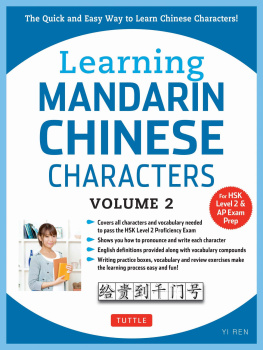

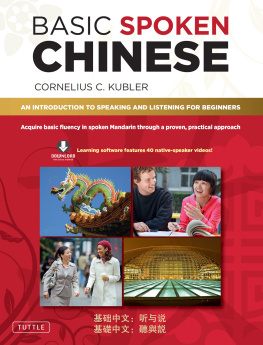
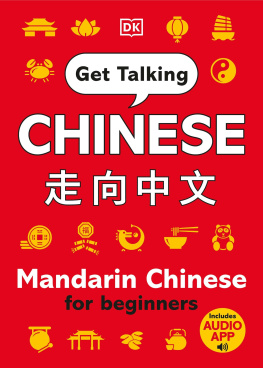
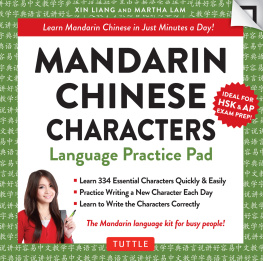
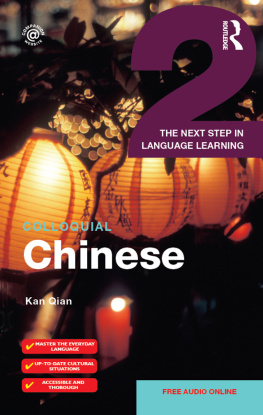
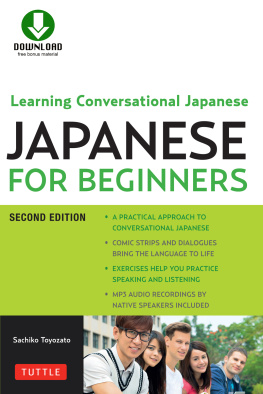
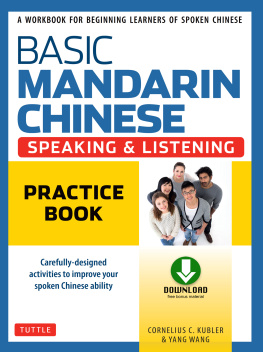
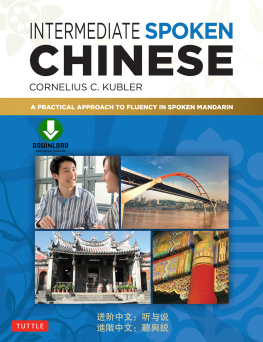
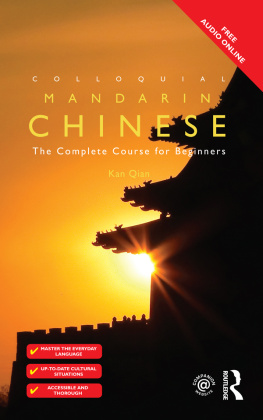
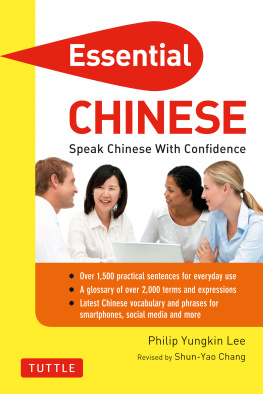

 To our families and our studentsABOUT TUTTLE Books to Span the East and West Our core mission at Tuttle Publishing is to create books which bring people together one page at a time. Tuttle was founded in 1832 in the small New England town of Rutland, Vermont (USA). Our fundamental values remain as strong today as they were thento publish best-in-class books informing the English-speaking world about the countries and peoples of Asia. The world has become a smaller place today and Asias economic, cultural and political influence has expanded, yet the need for meaningful dialogue and information about this diverse region has never been greater. Since 1948, Tuttle has been a leader in publishing books on the cultures, arts, cuisines, languages and literatures of Asia. Our authors and photographers have won numerous awards and Tuttle has published thousands of books on subjects ranging from martial arts to paper crafts.
To our families and our studentsABOUT TUTTLE Books to Span the East and West Our core mission at Tuttle Publishing is to create books which bring people together one page at a time. Tuttle was founded in 1832 in the small New England town of Rutland, Vermont (USA). Our fundamental values remain as strong today as they were thento publish best-in-class books informing the English-speaking world about the countries and peoples of Asia. The world has become a smaller place today and Asias economic, cultural and political influence has expanded, yet the need for meaningful dialogue and information about this diverse region has never been greater. Since 1948, Tuttle has been a leader in publishing books on the cultures, arts, cuisines, languages and literatures of Asia. Our authors and photographers have won numerous awards and Tuttle has published thousands of books on subjects ranging from martial arts to paper crafts. How to access the online Audio Recordings and Answer Key for this book: Check that you have an Internet connection. Type the URL below into to your web browser. https://www.tuttlepublishing.com/Mandarin-Chinese-for-Beginners For support email us at PinyinPn yn An ancient Chinese philosopher, Lao Zi, said: A journey of a thousand miles starts with one single step. So, now that you have this book open, what next? What is that first single step in learning Chinese? Its learning pinyin! Pinyin is a Romanized spelling system. When we learn English, we start with A, B, and C; and in learning Chinese, we start with pinyin. Did you know that Chinese children begin learning pinyin before they start to learn Chinese characters? Its used like the phonetic symbol system used in English: it shows us how to pronounce sounds, and then characters.
How to access the online Audio Recordings and Answer Key for this book: Check that you have an Internet connection. Type the URL below into to your web browser. https://www.tuttlepublishing.com/Mandarin-Chinese-for-Beginners For support email us at PinyinPn yn An ancient Chinese philosopher, Lao Zi, said: A journey of a thousand miles starts with one single step. So, now that you have this book open, what next? What is that first single step in learning Chinese? Its learning pinyin! Pinyin is a Romanized spelling system. When we learn English, we start with A, B, and C; and in learning Chinese, we start with pinyin. Did you know that Chinese children begin learning pinyin before they start to learn Chinese characters? Its used like the phonetic symbol system used in English: it shows us how to pronounce sounds, and then characters.